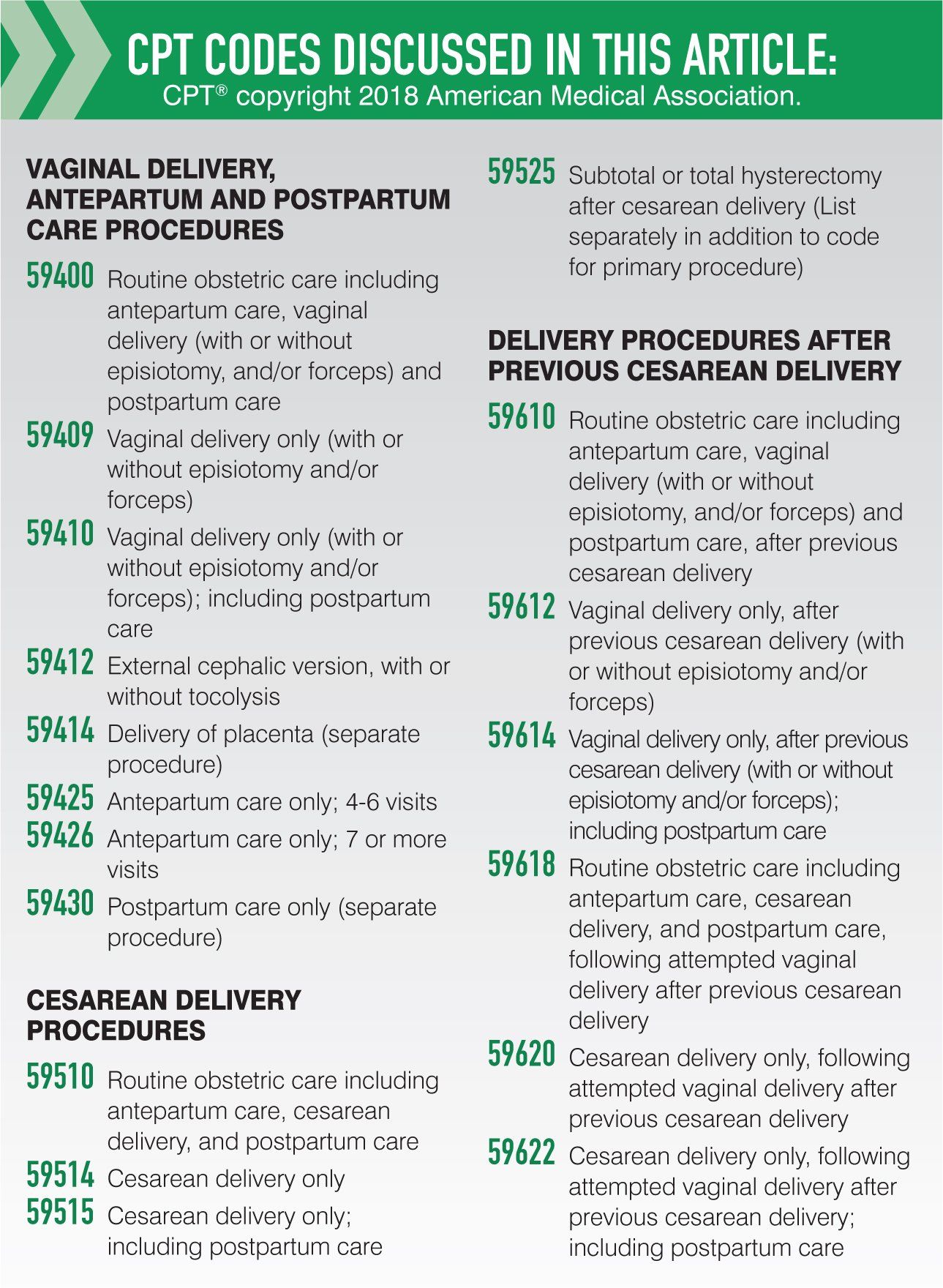Is it possible to make OB coding less complicated?
The sheer number of code options can be intimidating, but mastering a few concepts can alleviate some of the stress.

CPT codes discussed in this article

Just like our patients, proper coding and billing for obstetric patients can be…complicated. As a coding instructor and compliance auditor, I field a lot of questions from new students and experienced billers alike. In this article, I’ll break down a few of the most important concepts you need to understand to master obstetric coding.
The global period
Billing codes for maternity care and delivery are used to report antepartum care, vaginal or cesarean delivery, and postpartum care in uncomplicated pregnancies. Antepartum care includes the initial prenatal history and examination, subsequent prenatal history and examinations, recording of weight, blood pressures, fetal heart tones, routine chemical urinalysis, and monthly visits up to 28 weeks’ gestation; biweekly visits to 36 weeks’ gestation; and weekly visits until delivery. Delivery services include the hospital admission, management of uncomplicated labor, and cesarean or vaginal delivery (including episiotomy and repair if needed). Postpartum care includes visits in the hospital and a 6-week follow-up in the office following delivery. It may also include services related to a cesarean delivery, such as an incision check.
When billing for maternity care and delivery, codes exist to bill the global package (antepartum care, delivery, and postpartum care) or for specific components in the event you are billing for a provider who performed the antepartum care only, delivery only, or postpartum care only.
Note that pregnancy confirmation during a problem-oriented or preventive visit is not considered part of antepartum care and should be reported separately using the appropriate E/M code (for example an Outpatient Office Visit Code, 99201-99215). Also, remember that medical complications of pregnancy (eg, cardiac problems, neurological problems, diabetes, hypertension) and medical problems complicating labor and delivery management may require additional resources and should be billed separately – they are not included in the “global OB package.”
Delivery coding
When it comes to billing for maternity care and delivery, the number of code options can be confusing. Simply put, there are codes to report the global package, or components of it (as discussed above) depending on the method of delivery. For example, 59400 is used to report Routine OB care including antepartum care, vaginal delivery, and postpartum care. Codes immediately following 59400 report individual components of the global package. Code 59510 reports Routine OB care including antepartum care, cesarean delivery, and postpartum care.
However, there’s one more wrinkle that confuses some coders: Patients who have had a previous cesarean delivery and now present with an expectation of vaginal delivery have their own set of delivery codes, depending on the outcome. 59610 reports routine OB care including antepartum care, vaginal delivery, and postpartum care after a previous cesarean delivery. 59618 is used when the same patient with a previous cesarean attempts a vaginal delivery but delivers again via cesarean section.
ICD-10 concepts
With ICD-10 OB coding came a new set of billing guidelines that can be complicated, especially for newer coders trying to get acclimated to coding. The first important consideration when selecting a diagnosis code is to read the guidelines for each section. The ICD-10 guidelines state that codes for chapter 15 (Complications of Pregnancy, Childbirth, and the Puerperium) have sequencing priority over other codes from other chapters and are to be listed first unless the pregnancy is completely incidental and has nothing to do with the reason for the visit.
Another important consideration is the fact that in ICD-10, most of the diagnoses in chapter 15 include the concept of trimester. The guidelines state that not only should you select the code with the appropriate trimester for the current encounter, but a separate code (Z3A.--) should be used to report the weeks gestation for the encounter. For example, a patient in her 16th week of pregnancy should be assigned a code from chapter 15, followed by the code Z3A.16 to indicate 16 weeks’ gestation.
Routine vs problem visits
For a routine outpatient prenatal visit when no complications are present, select a diagnosis code from range Z34, Encounter for Supervision of Normal Pregnancy, as the primary diagnosis. Remember that on average, the global OB package encompasses 13 routine visits during pregnancy, which includes routine visits in uncomplicated cases, and 6 weeks postpartum care. This may include H&Ps, routine measurements, and educational services such as breastfeeding or basic newborn care. Services that are not part of the global OB package may be billed separately, such as an initial evaluation and management service to diagnose pregnancy, amniocentesis, cephalic version, additional E&M services for unrelated reasons (e.g., asthma or urinary tract infection) or greater frequency of visits due to a high-risk pregnancy. Sometimes coders get confused and either miss out on billing a service that isn’t included in the global OB package or they mistakenly try to bill for a visit that is included in the package.
Sometimes our patients (and our coding) can be routine, but other times things can get complicated. Having a good understanding of what is included can help you be prepared so that when you encounter a situation that isn’t included, you don’t forget to bill for it. It always helps to have your (heavily marked up and highlighted) coding manuals and/or cheat sheets nearby, and reimbursement policies from your office’s biggest payers on your computer.
Disclosures:
The author reports no potential conflicts of interest with regard to this article.

